Athena Review Vol.I,
no.4
Sites and Museums in Roman Gaul: Vienne and St.
Romain-en-Gal
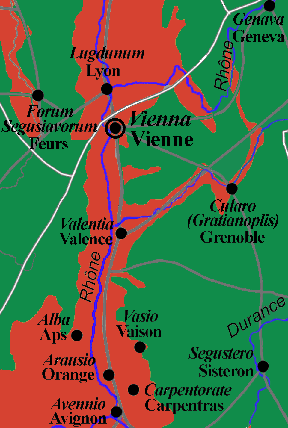 Occupying
both banks of the Rhône at the site of the former tribal capital of
the Allobroges, by AD 100 Vienne (Roman Vienna) had become a prosperous trading
emporium, considered by Tacitus in his Annals as a "historic and imposing
city". At first, however, when a colony for Roman veterans was established
here in the Gallic Wars, Vienna saw only mixed fortunes. During early battles
of Caesar's Gallic campaigns (58-56 BC), Vienna ("Colonia Julia Viennensis")
served as a supply depot and a camp for prisoners of war and hostages. Later,
both the Allobroges, then loyal to the Romans, and their old capital
at Vienna were targets of the Gallic revolt led by Vercingetorix in
52 BC. Upon Caesar's assassination in 44 BC, the resurgent Allobroges
expelled the Roman veterans from Vienna. These legionary soldiers then became
the original settlers of the nearby colony of Lugdunum (Lyon), starting a
long-term rivalry between the two cities. The next year (43 BC), Mark Antony
was sent to punish the Allobroges and establish another colony of veterans
at Vienna.
Occupying
both banks of the Rhône at the site of the former tribal capital of
the Allobroges, by AD 100 Vienne (Roman Vienna) had become a prosperous trading
emporium, considered by Tacitus in his Annals as a "historic and imposing
city". At first, however, when a colony for Roman veterans was established
here in the Gallic Wars, Vienna saw only mixed fortunes. During early battles
of Caesar's Gallic campaigns (58-56 BC), Vienna ("Colonia Julia Viennensis")
served as a supply depot and a camp for prisoners of war and hostages. Later,
both the Allobroges, then loyal to the Romans, and their old capital
at Vienna were targets of the Gallic revolt led by Vercingetorix in
52 BC. Upon Caesar's assassination in 44 BC, the resurgent Allobroges
expelled the Roman veterans from Vienna. These legionary soldiers then became
the original settlers of the nearby colony of Lugdunum (Lyon), starting a
long-term rivalry between the two cities. The next year (43 BC), Mark Antony
was sent to punish the Allobroges and establish another colony of veterans
at Vienna.
[Fig.1: Rhone Valley from Geneva to Avignon (Athena Review).]
Under Augustus the town, renamed Colonia Julia Augusta Florentia Vienna,
grew in commercial importance. Besides its favorable riverine location, Vienna
lay along several Roman roadways (fig.1) including the NS routes connecting
Colonia Agrippina (Cologne) to Massilia, and Lutetia (Paris) to the Alps
near Brigantio (Briançon), and two smaller EW routes from Vienna to
various points east, as shown in both the 2nd-3rd century AD Antonine
Itinerary and the early 3rd century AD Peutinger Table. The Roman
wall which eventually surrounded Vienne was the largest in Gaul, with a perimeter
of over four miles (6.5 km) and an enclosure of 544 acres (220 hectares),
about half that of
 Republican Rome.
Outside of the wall to the east of the city was the site of Vienna's Circus,
measuring 460 m (1492 feet) long and 120 m wide, suitable for a Ben Hur-sized
race of twelve chariots. The spina or center of the circus is still marked
by "La Pyramide," an Egyptian obelisk 15.5 m high sitting on top of a four-way
arcaded arch.
Republican Rome.
Outside of the wall to the east of the city was the site of Vienna's Circus,
measuring 460 m (1492 feet) long and 120 m wide, suitable for a Ben Hur-sized
race of twelve chariots. The spina or center of the circus is still marked
by "La Pyramide," an Egyptian obelisk 15.5 m high sitting on top of a four-way
arcaded arch.
Best preserved of Vienne's numerous Roman monuments is the Temple of Augustus
and Livia (fig.2) surviving nearly intact in the Place du Palais along
the Rue des Clercs. Almost the twin of the Maison Carrée in Nîmes,
it was originally dedicated to Augustus at the end of the 1st century BC,
then again dedicated in AD 41 to Livia, Augustus' wife, by her grandson,
the Emperor Claudius.
[Fig.2: The Temple of Augustus and Livia in Vienne (photo: Athena
Review).]
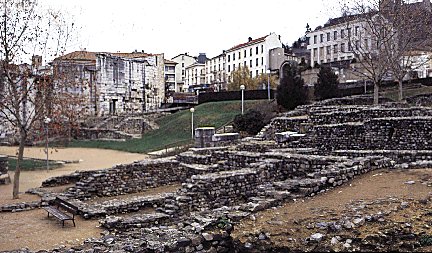 Vienna was the
only city in Roman Gaul to contain three theaters. The Odéon,
73 m in diameter, held 3000 spectators for music and public speaking ,and
was almost identical in size to the Odeon in Lyon. A smaller theater
was erected within the Shrine of Cybele (fig.3), a Near Eastern goddess
celebrated in mystery plays. Excavated between 1945-1968 by J. Formigé
and Pelletier, the Cybele theater and related temple complex contained an
underground room divided into a nave and side aisles. Pre-Roman pottery from
the mid-2nd century BC was found in the lowest levels.
Vienna was the
only city in Roman Gaul to contain three theaters. The Odéon,
73 m in diameter, held 3000 spectators for music and public speaking ,and
was almost identical in size to the Odeon in Lyon. A smaller theater
was erected within the Shrine of Cybele (fig.3), a Near Eastern goddess
celebrated in mystery plays. Excavated between 1945-1968 by J. Formigé
and Pelletier, the Cybele theater and related temple complex contained an
underground room divided into a nave and side aisles. Pre-Roman pottery from
the mid-2nd century BC was found in the lowest levels.
[Fig.3: Shrine of Cybele, Temple (photo: Athena Review).]
 The main
Theater (fig.4), built on a slope overlooking the town during the
reign of Augustus (27 BC-AD 14) has a diameter of 115 m, and was second only
to Autun as the largest theater in Gaul. Excavated and restored between 1922
and 1938 by M.J. Formigé, and still used today for concerts, the ancient
theater could hold up to 13,000 spectators. Seats of the first four rows,
5 cm wider than the rest, were made of pink breccia and white marble with
griffin's feet. The stage was faced with a 70 ft (21 m) frieze of animals
carved in relief, led by the god Dionysus who presided over the drama.
The main
Theater (fig.4), built on a slope overlooking the town during the
reign of Augustus (27 BC-AD 14) has a diameter of 115 m, and was second only
to Autun as the largest theater in Gaul. Excavated and restored between 1922
and 1938 by M.J. Formigé, and still used today for concerts, the ancient
theater could hold up to 13,000 spectators. Seats of the first four rows,
5 cm wider than the rest, were made of pink breccia and white marble with
griffin's feet. The stage was faced with a 70 ft (21 m) frieze of animals
carved in relief, led by the god Dionysus who presided over the drama.
[Fig.4: Theatre Antique in Vienne (photo: Athena Review).]
Across the Rhône from present-day Vienne is the archaeological park
and museum of St.-Romain-en-Gal, containing extensive remains of
residential and merchant quarters forming part of ancient Vienna. Throughout
a series of excavated streets in St. Romain-en-Gal are the foundations of
merchant stalls, workshops, several bath complexes, and houses
with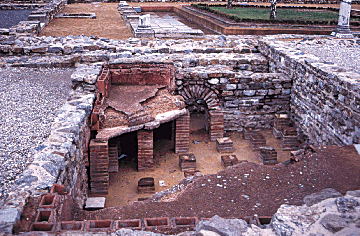 vestibulums,
whose mosaics and other remains are now in the museum. A Roman bath complex
immediately next to the museum, currently under excavation, is thought to
have included a religious shrine or memorial. This residential quarter,
largely abandoned by the end of the 3rd century AD, for over 200 years
contained prosperous shops and dwellings with costly utilitarian features
such as hypocausts (fig.5), and decorations including wall paintings and
mosaics, many recovered in virtually complete states and displayed in the
nearby museum.
vestibulums,
whose mosaics and other remains are now in the museum. A Roman bath complex
immediately next to the museum, currently under excavation, is thought to
have included a religious shrine or memorial. This residential quarter,
largely abandoned by the end of the 3rd century AD, for over 200 years
contained prosperous shops and dwellings with costly utilitarian features
such as hypocausts (fig.5), and decorations including wall paintings and
mosaics, many recovered in virtually complete states and displayed in the
nearby museum.
[Fig.5: Hypocaust in 2nd century AD house at St.-Romain-en-Gal
(photo: Athena Review).]
The Musée Archéologique at St.-Romain-en-Gal contains
a variety of well-organized displays on riverine trade activities and the
flourishing community in Roman-era Vienne. Central to the museum is its
imaginative display of rooms from Gallo- Roman houses and their wall
paintings and mosaics, the latter seen advantageously from above
via a series of catwalks. Typically early (1st century AD) geometric patterns
alternate with later (2nd-3rd century AD) figurative mosaics, many containing
nature-related themes. One large pavement shows Orpheus surrounded by animals,
a theme typically seen in
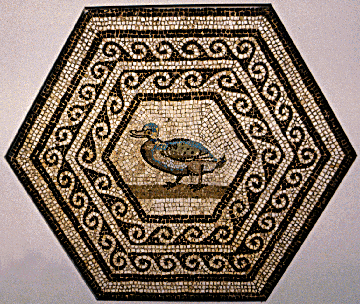 Roman house mosaics.
Orpheus was a Thracian hero who sang and played the lyre with such art that
wild animals would run to listen. This central scene is surrounded by a series
of octagonal panels showing an variety of semi-realistic animals ranging
from leopards to deer. Several other mosaic fragments from Roman houses in
Vienne also depict plants and animals including a duck, symbol of hospitality,
from the late 2nd century (fig.6). The massive Lycurgus Mosaic, displayed
in a darkened room with continuously changing light, shows the Thracian king
Lycurgus at the center of a dark green background interwoven with an intricate
gold foliage motif. The myth told that Lycurgus, for banning the worship
of Bacchus, was punished with madness and death. The scene depicted in the
mosaic shows Lycurgus slaying his son, Dryas, whom he has mistaken for
vine-stock.
Roman house mosaics.
Orpheus was a Thracian hero who sang and played the lyre with such art that
wild animals would run to listen. This central scene is surrounded by a series
of octagonal panels showing an variety of semi-realistic animals ranging
from leopards to deer. Several other mosaic fragments from Roman houses in
Vienne also depict plants and animals including a duck, symbol of hospitality,
from the late 2nd century (fig.6). The massive Lycurgus Mosaic, displayed
in a darkened room with continuously changing light, shows the Thracian king
Lycurgus at the center of a dark green background interwoven with an intricate
gold foliage motif. The myth told that Lycurgus, for banning the worship
of Bacchus, was punished with madness and death. The scene depicted in the
mosaic shows Lycurgus slaying his son, Dryas, whom he has mistaken for
vine-stock.
[Fig.6: Mosaic of Hospitality, from 2nd-3rd century AD Roman house
(Musée Archéologique de St.-Romain-en-Gal ; photo: Athena
Review).]
Wall Paintings from houses or villas depict candelabras and fountains,
wine bottles, and other domestic items, as well as architectural motifs,
animals, and plants, including flowers and grapes. Some of the more singular
themes include a winged genie; a 1st century AD scene of wading birds and
water lilies found in 1977 in the garden portico of a Roman house; and a
painting from the baths latrine, showing three panels with famous wrestlers.
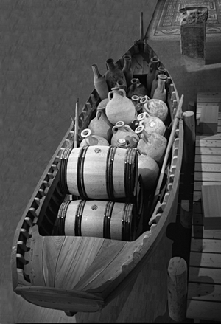 Notable pieces
of sculpture include a 1st century AD phallic-shaped fountain, and
a 2nd century AD relief statue of the Gallo-Roman fertility god Sucellus,
shown with his typical attributes: a mallet, a cup, and a dog. Other fragments
include the marble head of a young girl, a domestic altar, and an inscribed
statue base. The epitaph of G. Libertius Decimanus, found in Lyon, bears
an inscription showing he was a native of Vienna.
Notable pieces
of sculpture include a 1st century AD phallic-shaped fountain, and
a 2nd century AD relief statue of the Gallo-Roman fertility god Sucellus,
shown with his typical attributes: a mallet, a cup, and a dog. Other fragments
include the marble head of a young girl, a domestic altar, and an inscribed
statue base. The epitaph of G. Libertius Decimanus, found in Lyon, bears
an inscription showing he was a native of Vienna.
Artifacts and technology: Among the most interesting exhibits related
to daily life is a full scale replica of a Roman river boat filled with a
cargo of amphorae and barrels (fig.7), the latter an invention of the Gauls.
Related displays on the industry and shipping around Vienna. includes scale
models of the Roman city and its extensive warehouse complex. These flank
an amphora and dolia collection (vessels for transport and storage) with
a potter's kiln. Further displays cover mosaic manufacture, showing tools
of the mosaicists craft. Overall, the museum combines the best of the old
and the new, with a magnificent archaeological collection from Vienne displayed
along the Rhône amid futuristic decor and ample natural lighting.
[Fig.7: Full-size model of Roman river boat with cargo (Musée
Archéologique de St.-Romain-en-Gal ; photo: Athena Review).]
Athena Review Image
Archive™ |
Paleoanthropology in
the News
| Guide
to Archaeology on the Internet |
Free issue
|
Back issues
Main index of Athena
Review |
Subject Index
| Travel
Pages |
Galleries and
Museums |
Ad
rates |
Current issue
index |
Copyright © 1996-2001 Athena
Publications, Inc. (All Rights Reserved).
 Occupying
both banks of the Rhône at the site of the former tribal capital of
the Allobroges, by AD 100 Vienne (Roman Vienna) had become a prosperous trading
emporium, considered by Tacitus in his Annals as a "historic and imposing
city". At first, however, when a colony for Roman veterans was established
here in the Gallic Wars, Vienna saw only mixed fortunes. During early battles
of Caesar's Gallic campaigns (58-56 BC), Vienna ("Colonia Julia Viennensis")
served as a supply depot and a camp for prisoners of war and hostages. Later,
both the Allobroges, then loyal to the Romans, and their old capital
at Vienna were targets of the Gallic revolt led by Vercingetorix in
52 BC. Upon Caesar's assassination in 44 BC, the resurgent Allobroges
expelled the Roman veterans from Vienna. These legionary soldiers then became
the original settlers of the nearby colony of Lugdunum (Lyon), starting a
long-term rivalry between the two cities. The next year (43 BC), Mark Antony
was sent to punish the Allobroges and establish another colony of veterans
at Vienna.
Occupying
both banks of the Rhône at the site of the former tribal capital of
the Allobroges, by AD 100 Vienne (Roman Vienna) had become a prosperous trading
emporium, considered by Tacitus in his Annals as a "historic and imposing
city". At first, however, when a colony for Roman veterans was established
here in the Gallic Wars, Vienna saw only mixed fortunes. During early battles
of Caesar's Gallic campaigns (58-56 BC), Vienna ("Colonia Julia Viennensis")
served as a supply depot and a camp for prisoners of war and hostages. Later,
both the Allobroges, then loyal to the Romans, and their old capital
at Vienna were targets of the Gallic revolt led by Vercingetorix in
52 BC. Upon Caesar's assassination in 44 BC, the resurgent Allobroges
expelled the Roman veterans from Vienna. These legionary soldiers then became
the original settlers of the nearby colony of Lugdunum (Lyon), starting a
long-term rivalry between the two cities. The next year (43 BC), Mark Antony
was sent to punish the Allobroges and establish another colony of veterans
at Vienna.
 Republican Rome.
Outside of the wall to the east of the city was the site of Vienna's Circus,
measuring 460 m (1492 feet) long and 120 m wide, suitable for a Ben Hur-sized
race of twelve chariots. The spina or center of the circus is still marked
by "La Pyramide," an Egyptian obelisk 15.5 m high sitting on top of a four-way
arcaded arch.
Republican Rome.
Outside of the wall to the east of the city was the site of Vienna's Circus,
measuring 460 m (1492 feet) long and 120 m wide, suitable for a Ben Hur-sized
race of twelve chariots. The spina or center of the circus is still marked
by "La Pyramide," an Egyptian obelisk 15.5 m high sitting on top of a four-way
arcaded arch.
 Vienna was the
only city in Roman Gaul to contain three theaters. The Odéon,
73 m in diameter, held 3000 spectators for music and public speaking ,and
was almost identical in size to the Odeon in Lyon. A smaller theater
was erected within the Shrine of Cybele (fig.3), a Near Eastern goddess
celebrated in mystery plays. Excavated between 1945-1968 by J. Formigé
and Pelletier, the Cybele theater and related temple complex contained an
underground room divided into a nave and side aisles. Pre-Roman pottery from
the mid-2nd century BC was found in the lowest levels.
Vienna was the
only city in Roman Gaul to contain three theaters. The Odéon,
73 m in diameter, held 3000 spectators for music and public speaking ,and
was almost identical in size to the Odeon in Lyon. A smaller theater
was erected within the Shrine of Cybele (fig.3), a Near Eastern goddess
celebrated in mystery plays. Excavated between 1945-1968 by J. Formigé
and Pelletier, the Cybele theater and related temple complex contained an
underground room divided into a nave and side aisles. Pre-Roman pottery from
the mid-2nd century BC was found in the lowest levels.
 The main
Theater (fig.4), built on a slope overlooking the town during the
reign of Augustus (27 BC-AD 14) has a diameter of 115 m, and was second only
to Autun as the largest theater in Gaul. Excavated and restored between 1922
and 1938 by M.J. Formigé, and still used today for concerts, the ancient
theater could hold up to 13,000 spectators. Seats of the first four rows,
5 cm wider than the rest, were made of pink breccia and white marble with
griffin's feet. The stage was faced with a 70 ft (21 m) frieze of animals
carved in relief, led by the god Dionysus who presided over the drama.
The main
Theater (fig.4), built on a slope overlooking the town during the
reign of Augustus (27 BC-AD 14) has a diameter of 115 m, and was second only
to Autun as the largest theater in Gaul. Excavated and restored between 1922
and 1938 by M.J. Formigé, and still used today for concerts, the ancient
theater could hold up to 13,000 spectators. Seats of the first four rows,
5 cm wider than the rest, were made of pink breccia and white marble with
griffin's feet. The stage was faced with a 70 ft (21 m) frieze of animals
carved in relief, led by the god Dionysus who presided over the drama.
 vestibulums,
whose mosaics and other remains are now in the museum. A Roman bath complex
immediately next to the museum, currently under excavation, is thought to
have included a religious shrine or memorial. This residential quarter,
largely abandoned by the end of the 3rd century AD, for over 200 years
contained prosperous shops and dwellings with costly utilitarian features
such as hypocausts (fig.5), and decorations including wall paintings and
mosaics, many recovered in virtually complete states and displayed in the
nearby museum.
vestibulums,
whose mosaics and other remains are now in the museum. A Roman bath complex
immediately next to the museum, currently under excavation, is thought to
have included a religious shrine or memorial. This residential quarter,
largely abandoned by the end of the 3rd century AD, for over 200 years
contained prosperous shops and dwellings with costly utilitarian features
such as hypocausts (fig.5), and decorations including wall paintings and
mosaics, many recovered in virtually complete states and displayed in the
nearby museum.
 Roman house mosaics.
Orpheus was a Thracian hero who sang and played the lyre with such art that
wild animals would run to listen. This central scene is surrounded by a series
of octagonal panels showing an variety of semi-realistic animals ranging
from leopards to deer. Several other mosaic fragments from Roman houses in
Vienne also depict plants and animals including a duck, symbol of hospitality,
from the late 2nd century (fig.6). The massive Lycurgus Mosaic, displayed
in a darkened room with continuously changing light, shows the Thracian king
Lycurgus at the center of a dark green background interwoven with an intricate
gold foliage motif. The myth told that Lycurgus, for banning the worship
of Bacchus, was punished with madness and death. The scene depicted in the
mosaic shows Lycurgus slaying his son, Dryas, whom he has mistaken for
vine-stock.
Roman house mosaics.
Orpheus was a Thracian hero who sang and played the lyre with such art that
wild animals would run to listen. This central scene is surrounded by a series
of octagonal panels showing an variety of semi-realistic animals ranging
from leopards to deer. Several other mosaic fragments from Roman houses in
Vienne also depict plants and animals including a duck, symbol of hospitality,
from the late 2nd century (fig.6). The massive Lycurgus Mosaic, displayed
in a darkened room with continuously changing light, shows the Thracian king
Lycurgus at the center of a dark green background interwoven with an intricate
gold foliage motif. The myth told that Lycurgus, for banning the worship
of Bacchus, was punished with madness and death. The scene depicted in the
mosaic shows Lycurgus slaying his son, Dryas, whom he has mistaken for
vine-stock.
 Notable pieces
of sculpture include a 1st century AD phallic-shaped fountain, and
a 2nd century AD relief statue of the Gallo-Roman fertility god Sucellus,
shown with his typical attributes: a mallet, a cup, and a dog. Other fragments
include the marble head of a young girl, a domestic altar, and an inscribed
statue base. The epitaph of G. Libertius Decimanus, found in Lyon, bears
an inscription showing he was a native of Vienna.
Notable pieces
of sculpture include a 1st century AD phallic-shaped fountain, and
a 2nd century AD relief statue of the Gallo-Roman fertility god Sucellus,
shown with his typical attributes: a mallet, a cup, and a dog. Other fragments
include the marble head of a young girl, a domestic altar, and an inscribed
statue base. The epitaph of G. Libertius Decimanus, found in Lyon, bears
an inscription showing he was a native of Vienna.